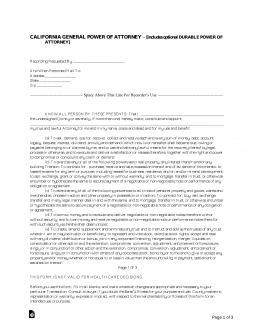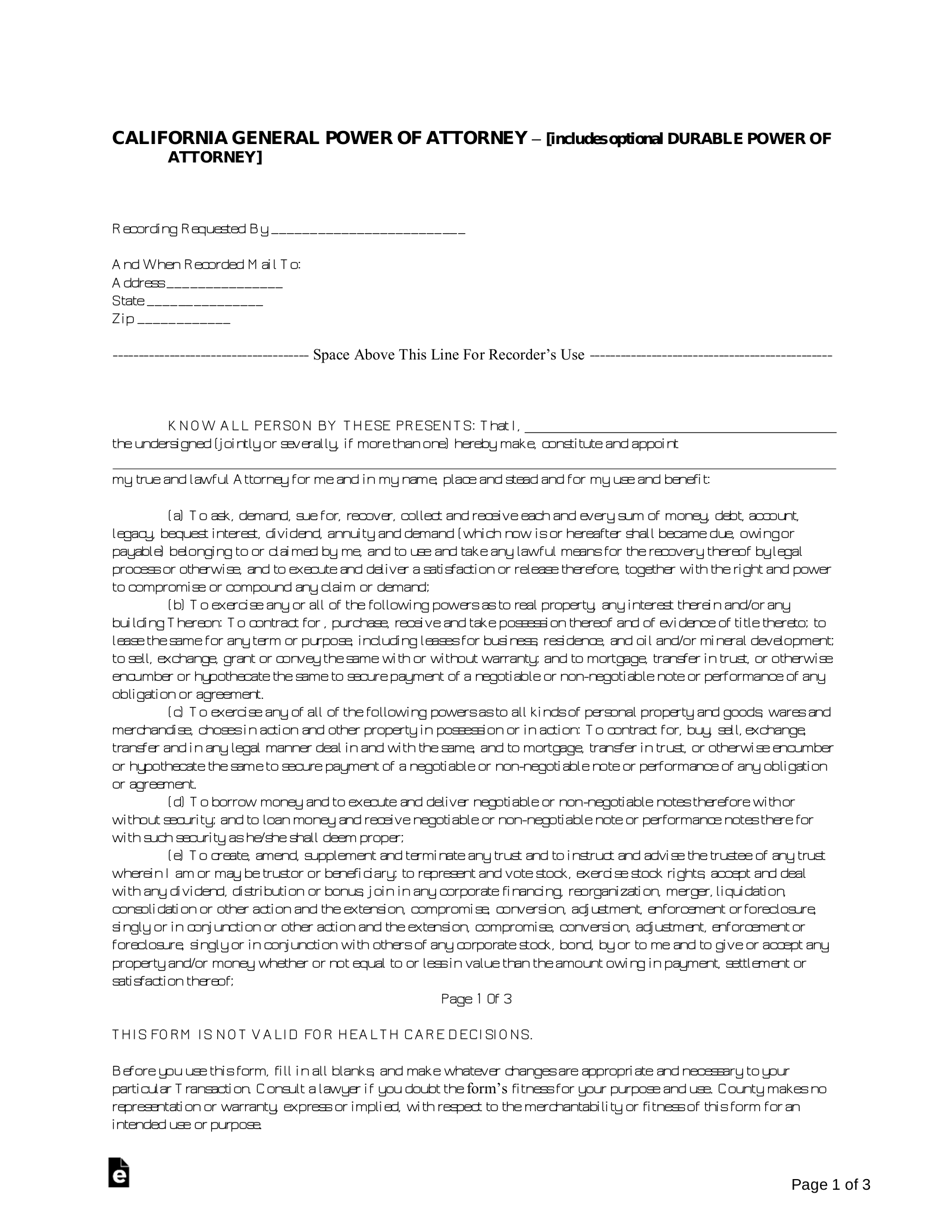Updated August 08, 2023
A California general power of attorney (GPOA) transfers the authority to act on financial matters from one person to another. This type of power of attorney is non-durable, which means that it only remains in effect while the principal is alive and not incapacitated (Dementia, Alzheimer’s Disease, etc.).
It is not a durable power of attorney (although it can be made into one), as it becomes void if the principal can no longer make decisions.
Laws
- Statutes – Probate Code Division 4.5. Powers of Attorney [4000 – 4545]
- Authority (Prob. Code § 4450) – An agent under a power of attorney may act on behalf of the principal and exercise broad authority as granted by the agreement.
- Signing Requirements (Prob. Code § 4121) – Two (2) Witnesses or a Notary Public.
How to Write
Download: PDF, MS Word, OpenDocument
1 – Record The Identity of the Principal And the Agent
The Principal and Agent will set a relationship, defined by this document, through the finalization of this form. Here, the Principal will grant the Agent or Attorney-in-Fact his or her authority over the matters defined here. That is, for each defined Power of Authority given, the Attorney-in-Fact will be able to make decisions, act, and/or is entitled to disclosures just as if he or she was the Principal. A few items will need to be defined on this form.
To begin, locate the phrase “Know All Person…” then enter the Name of the Principal in the first available area.![]()
In the next blank space, report the Full Name of the Agent.![]()
2 – Authority And Durability
The paragraphs making up this page will provide important information in relation to the powers being granted through this document. However, some information will be required to define the Principal’s intentions regarding the Agent’s Principal Power.
Locate Item G. Here, it will be necessary to disclose whether this document remains active in the event the Principal is rendered disabled or even incapacitated. If the Principal wishes the Attorney-in-Fact to retain Authority after such an event, the number of years after the event where the Authority remains intact must be reported on the blank space in this item. If the Principal does not wish the Attorney-in-Fact to retain authority when he or she becomes incapacitated, then strike through this statement with a horizontal line.![]()
Locate Item H, if the powers being assigned and granted through this form should become effective the moment the Principal becomes disabled or incapacitated, then enter the Number of Years such powers and authority will remain active on the blank space provided. If this statement should not be applied to this document, then strike through it.![]()
3 – Required Notice Verification
The Agent or Attorney-in-Fact being granted this power must formally acknowledge and accept this responsibility. This should be done by having the Agent read the section labeled “Notice To Person Accepting The Appointment As Attorney-in-Fact.” Once this task has been completed, the Agent must provide the Date he or she is signing this statement on the blank line labeled “Date.” On the line adjacent to this the Agent must Sign his or her Name.
The Principal will also need to provide verification, especially since such paperwork may carry a significant impact. The Principal must read the statement titled “Giving And Granting.” When he or she is ready, the Date must be entered across the blank spaces after the word “Witness…” and the Principal’s Signature must be provided on the blank line below this.
The area below the Principal Signature has been developed so the Notary Public may notarize this document easily. Make sure he or she fills in the requested information then provide his or her Signature and Seal
Make sure you have ample copies for the County Recorder’s Office, the Attorney-in-Fact, any relevant institutions, and the Principal. Keep a roster of who and where this document has been submitted to.


